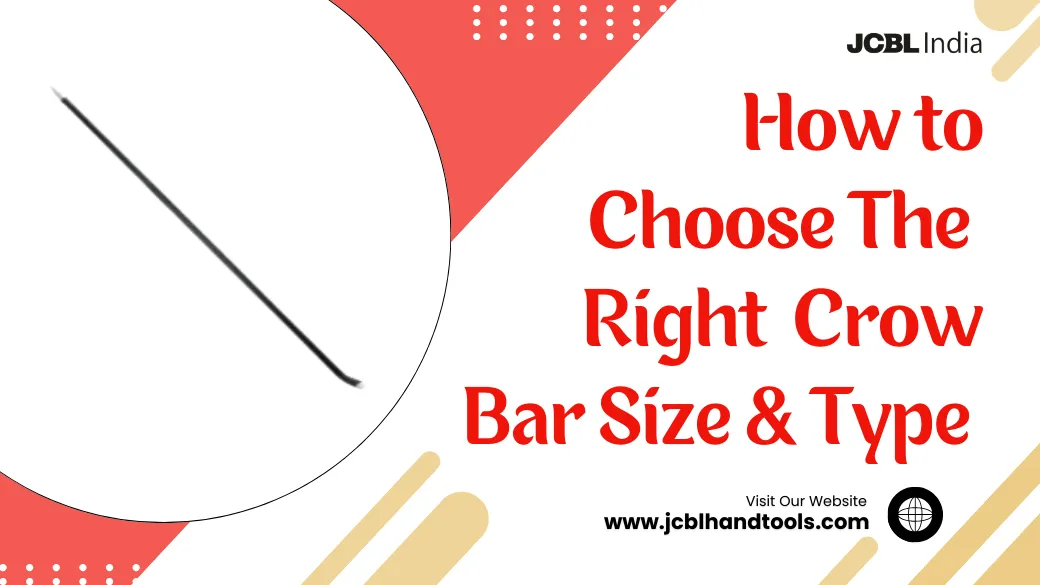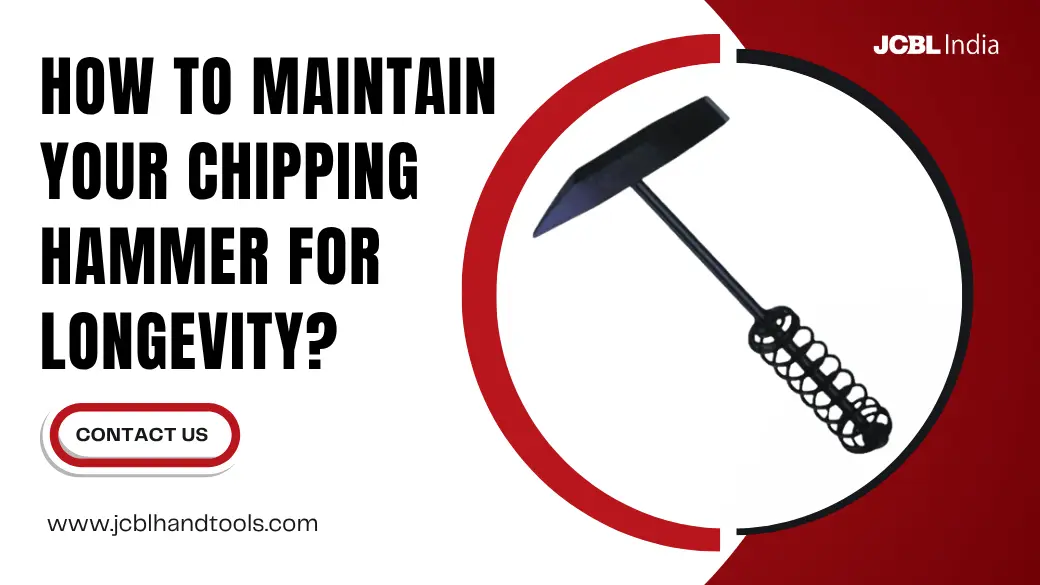How to Choose the Right Crow Bar: Size & Type Guide

Crowbars may seem like a basic tool, but their power, versatility, and engineering make them indispensable in both professional and DIY toolkits. Whether you’re prying apart wooden crates, lifting stubborn tiles, or demolishing drywall, the right crowbar does the job faster, safer, and with less effort. But with various types, lengths, and builds available, how do you choose the perfect one for your task?
Let’s dive deep into the world of crowbars and help you pick the best-suited one for your needs, with a special focus on high-performance tools from JCBL Hand Tools, a name trusted by professionals across the globe.
What is Crowbar? — Design, Size, and Purpose
At its core, a crowbar is a long, robust metal tool used to apply leverage in tasks like pulling, lifting, prying, or demolishing. It is commonly grouped under hand tools and can also be considered a striking tool when used for tasks that require force. It’s also known by other names like pry bar, wrecking bar, or pinch bar, depending on its design and use.
Design
A typical crowbar features:
- A straight or slightly curved shaft
- A forked claw or chisel-like edge at one or both ends
- Some models include a gooseneck bend for added leverage
Crowbars are usually forged from hardened steel and may come with coatings to resist rust and wear.
Size Range
Crowbars are available in multiple sizes:
- Small (8–12 inches): Ideal for tight spaces or delicate tasks
- Medium (15–24 inches): Balanced for general repairs and remodeling
- Large (30–60 inches): Best for heavy-duty demolition or industrial use
Primary Purpose
Crowbars are used for:
- Removing nails or fasteners
- Opening crates or containers
- Separating joined materials (wood, metal, tiles)
- Lifting heavy objects slightly for insertion of support
Types of Crowbar
Understanding the different types of crowbars is essential to choosing the right one for your specific task. Each variant is engineered for distinct applications based on its shape, size, and leverage capabilities.
Gooseneck Crowbar
The gooseneck crowbar features a sharply curved end with a claw, making it ideal for heavy-duty tasks like pulling nails, prying apart wood, and demolition work. Its unique bend offers maximum leverage, allowing users to apply significant force with minimal effort, especially in construction and renovation environments.
Flat Bar (Wonder Bar)
This thin, flat, and wide crowbar with beveled edges is perfect for tasks requiring finesse, such as trim removal, flooring, and general carpentry. Lightweight and easy to handle, the flat bar is excellent for tight spaces and provides controlled prying without damaging surrounding surfaces.
Rolling Head Pry Bar
The rolling head pry bar has a curved end designed for precise leverage, especially in confined or awkward angles. It’s commonly used in automotive repairs, industrial alignment, and machinery setup where precision and controlled pressure are essential for adjusting components or aligning parts.
Digging Bar / Pinch Bar
Long, straight, and extremely robust, the digging or pinch bar is crafted with a pointed or chisel-like end for breaking hard surfaces such as compacted soil, ice, or concrete. This type is a staple in landscaping and construction, often used to dig, break ground, or uproot obstructions.
Aligning Bar
An aligning bar is a straight tool with tapered ends that helps in positioning or aligning heavy components before fastening. Frequently used in steel erection, rigging, and industrial assembly, it allows workers to maneuver and adjust parts accurately without applying excessive force.
Applications of Crowbars
Crowbars aren’t limited to demolition; they’re powerful, multi-purpose tools used across various industries and settings. Here’s how different fields rely on them for everyday operations:
Construction & Renovation
In construction and renovation, crowbars are essential for tasks like pulling out old nails, lifting floorboards, and dismantling wooden frames. They’re also commonly used to remove tiles, baseboards, and drywall with precision, reducing damage to surrounding structures during remodeling or tear-down projects.
Automotive Repair
Crowbars in automotive settings help mechanics realign components, separate corroded or tightly fused parts, and remove vehicle moldings and trim without damaging the body. Their slim design and strong leverage make them a go-to tool for prying or adjusting hard-to-move elements in compact engine spaces.
Landscaping & Outdoor Use
For landscapers and gardeners, crowbars are invaluable for digging through rocky soil, loosening embedded roots, and breaking frozen ground. They’re also commonly used to uproot wooden or metal fence posts and stakes, saving time and effort when redesigning or clearing outdoor spaces.
Industrial & Mechanical
In industrial environments, crowbars assist in aligning heavy machinery, lifting or positioning bulky parts, and opening sealed containers or crates. Their strength and reach allow workers to apply precise force without damaging sensitive equipment, making them crucial in both assembly and maintenance tasks.
DIY & Household
Crowbars are a favorite among DIYers for furniture disassembly, wall mounting, and home repairs. Whether you’re prying apart an old bookshelf, lifting floor tiles, or removing wall panels, a well-sized crowbar helps you get the job done efficiently with minimal damage and effort.
How to Choose the Right Crowbar: Based on Size and Type
Selecting the ideal crowbar depends on what you need it for. Here’s how to narrow down your choice:
- Match the Tool to the Task: One of the most important things in selecting a tool is to first understand its suitability for the task.
- Light Prying or Detail Work: Go for a flat bar in the 10–15 inch range.
- General Demolition: A gooseneck crowbar around 24–36 inches offers the right power-to-control ratio.
- Heavy-Duty Construction or Landscaping: A digging or pinch bar, 48 inches or longer, is your best friend.
- Precision Work in Tight Spaces: Opt for a rolling head or aligning bar.
- Leverage vs. Portability: Longer bars provide better leverage but are heavier and harder to maneuver. Shorter bars are more compact but require more manual force for tough jobs.
- Ergonomics: Look for bars with angled claws, textured shafts, or rubber grips for comfort and safety.
- Multi-Use Options: Some crowbars are double-ended with different functions (e.g., nail puller on one side, chisel on the other). These are excellent for fieldwork where carrying multiple tools isn’t feasible.
What Really Matters? — Material & Build
Not all crowbars are created equal. A poor-quality bar can bend under pressure or wear out quickly. Here’s what truly matters when it comes to quality:
Material Composition
- Forged Alloy Steel is the gold standard for strength and durability.
- JCBL Hand Tools uses heat-treated alloy steel to ensure the bar maintains its shape even under high force.
Surface Finish
- Anti-rust coatings like black oxide, powder coating, or chrome plating increase tool lifespan.
- Choose a finish that suits your working environment (wet, dry, dusty).
Construction Technique
- Single-piece forged bars are stronger and more reliable than welded or assembled ones.
- JCBL crowbars are precisely forged for structural integrity and long-term use.
Why Choose JCBL Hand Tools for Your Crowbar Needs?
When you’re investing in a tool meant for strength, precision, and longevity—cutting corners isn’t an option. That’s where JCBL Hand Tools excels.
Why Professionals Trust JCBL Hand Tools’ Crowbars:
- Premium Forged Steel Construction: Manufactured with high-grade, heat-treated alloy steel to withstand maximum force without bending or breaking.
- Variety of Types & Sizes: From flat bars to gooseneck crowbars, JCBL offers a wide range to cater to every job—from delicate to heavy-duty.
- Corrosion-Resistant Finishes: Each crowbar is coated with a protective finish to resist rust and extend shelf life, especially in tough environments.
- Precision Engineering: Designed for optimal grip, balance, and leverage, JCBL crowbars reduce fatigue and increase efficiency.
- Tested for Real-World Use: All tools undergo rigorous quality control checks and are field-tested by professionals across industries.
Whether you’re a carpenter, mechanic, mason, or DIY enthusiast—JCBL Hand Tools delivers crowbars that you can trust every single time.
Conclusion
Choosing the right crowbar isn’t just about picking a tool—it’s about choosing the right extension of your arm that works with you, not against you.
From prying up wood panels to aligning industrial components, there’s a perfect crowbar out there for your task. And when you choose JCBL Hand Tools, you’re not just getting a tool—you’re investing in reliability, performance, and precision.
Ready to pry, pull, and demolish like a pro? Explore the full range of JCBL crowbars today and experience tools that are built to perform and built to last.
FAQs
What is the difference between a crowbar and a pry bar?
While often used interchangeably, a crowbar typically refers to a larger, curved tool for heavy-duty jobs, while a pry bar is often flat, shorter, and suited for lighter tasks.
What size crowbar is best for demolition?
A 24- to 36-inch gooseneck crowbar is ideal for general demolition work. For major industrial teardown, 48-inch or longer bars offer the best leverage.
Can crowbars be used for digging?
Yes, digging or pinch bars are a specific type of crowbar designed for breaking soil, ice, or concrete, often used in landscaping and post-hole digging.
How do I maintain my crowbar?
Wipe it down after use, store it in a dry place, and occasionally oil it if exposed to moisture. JCBL’s anti-rust finishes already offer enhanced protection.



